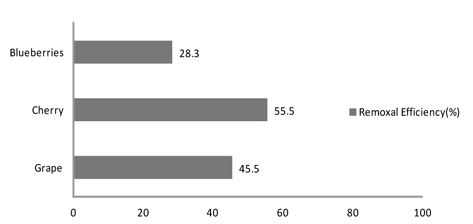



This study was conducted to investigate the levels of pesticide residues in fruits and to assess their risk to human health.
Monitoring of 215 samples of fruits collected from local markets in incheon during 2013 was performed. 259 pesticides were analyzed by multi-residue method and Quick, Easy, Cheap, Effective, Rugged, and safe/Mass/Mass(QuEChERS/MS/MS) method using Gas Chromatography-Electron Capture Detector/Nitrogen Phosphorus Detector(GC-ECD/NPD), GC-MS, LC(Liquid Chromatography-Mass/Mass(LC-MS/MS) and High Performance Liquid Chromatography-Photodiode Array/Fluorescence Detector(HPLC-PDA/FLD). In 56.3% of the samples detected pesticide residues and were not found to exceed Maximum Residue Limits(MRL). The highest detected samples were found in citrus fruits(83.9%). Among the detected compounds, carbendazim(13.1%), imazalil (11.7%), thiabendazole(10.7%) and fludioxonil(9.8%) were frequently found in fruits. A risk assessment of pesticide residues in fruits was performed by calculating Estimated Daily Intake(EDI) and Acceptable Daily Intake(ADI). Also, we were evaluated removal efficiency of pesticide residues by washing and peeling. The removal efficiency of pesticide residues in citrus and tropical fruits by peeling processes were 91.6%. After the washing process, the removal rates were 43.1%(Cherry, Grape, Blueberry).
The level of pesticide residues in fruits was within the MRL. The range of %ADI values was from 0.00011 to 0.98795%. The process of washing or peeling reduces the level of pesticide residues. The results of this research concluded that the detected pesticides are not harmful to human being.
경제발전에 따른 생활수준의 향상⋅고령화로 인하여 현대인들은 건강에 대한 관심이 매우 높아졌다. 식품선택의 기준도 단순히 맛, 가격, 영양소 이외에 기능성 및 안전성도 식품 소비에 큰 영향을 미치고 있다. 과일류는 항암효과, 항산화효과, 피부 미용 및 다이어트 등에 도움이 된다고 알려지면서(Bao, M.J.,
최근 몇 년간 시중에 유통되고 있는 수입과일류에 기준치를 초과한 농약이 검출되었다는 언론보도(소비자시민모임, 2012) 와 대부분 조리과정을 거치지 않고 섭취하는 과일류의 특성상 소비자들이 가지는 잔류농약에 대한 불안감은 높을 수밖에 없다. 하지만, 기후 및 농업환경이 다변화하면서 세계 각국에서 다양한 농약 사용이 불가피한 것이 사실이다. 실제로 농약을 사용하지 않는다면 농산물 생산량이 20∼75% 까지 감소 될 수 있고 더 많은 노동력과 경작지를 필요로 한다고 한다(Darby, W.J., 1964; Ridgway, R.L., 1978). 각 나라별 재배환경, 발생하는 병충해 종류가 다르므로 방제하는 농약의 종류와 양도 달라서 각 국가별로 최대잔류농약허용기 준(Maximum residue Limits, MRL) 및 농약안전사용 기준을 설정하여 관리하고 있다. 나라마다 다른 MRL과 농약안 전사용 기준은 수입농산물 안전성 관리에 문제를 야기할 수있다. 따라서 각 국은 자국의 농산물안전성 확보를 위해 기준이 설정되지 않은 농약이 0.01 mg/kg 이상 잔류하는 농산물의 판매 등을 금지하는 Positive list, 자국에 허용기준이 설정되어 있지 않은 농약에 대해서 불검출을 원칙으로 하는 Zero tolerance 등을 도입하여 자국내 유통되는 농산물의 안전성 확보에 주력하고 있다. 국내의 경우 해당 농산물의 기준이 설정되어 있지 않은 농산물의 경우 Codex 기준적용 및 유사농산물 최저기준을 적용하고 있다.
국내 수입농산물의 경우 최초 수입, 무작위표본검사, 부적합 이력이 있는 식품에 대해서만 잔류농약을 포함한 정밀검사가 실시되고 (식품의약품안전처 수입식품 등 검사연보, 2011) 있으며, 수입 농⋅임산물 대비 정밀검사(무작위 표본검사 포함)가 시행되고 있는 비율은 전체 수입 농⋅임산물에 16.7%에 불과한 것으로 조사되었다(수입식품 등 검사연보, 2012). 급증하는 수입식품의 양에 비해 농⋅임산물의 정밀검사 비율은 가공식품 31.9%, 건강기능식품 34.0%, 식품첨가물 27.8%에 비해 낮다. 따라서 유통되고 있는 수입농산물에 대한 좀 더 적극적이고 지속적인 잔류농약 안전성 조사가 필요할 것이다.
본 연구에서는 인천시에서 유통되는 수입 과일류(오렌지, 레몬, 자몽, 키위, 바나나, 망고, 체리, 블루베리, 포도) 9종 144건, 국내산 과일류(감귤, 레몬, 키위, 망고, 체리, 블루베리, 포도) 7종 71건을 대상으로 잔류농약 모니터링을 실시하였고, 검출빈도가 높고 해당농산물에 대한 잔류허용기준이 설정되어 있지 않은 농약성분에 대한 위해성 평가를 실시하였다. 또한 실제 소비자들이 섭취하는 형태인 과피 제거, 물을 이용한 세척 후 농약 잔류량 변화를 비교하여 실제 섭취되는 잔류농약의 양을 조사하였다.
2013년 1월부터 11월까지 인천시내 대형마트, 재래시장, 도매시장에서 유통되고 있는 과일류를 대상으로 하였으며, 시료별 수거현황 및 원산지는 Table 1과 같다. 분석농약은 식품공전 다종농약다성분 분석법 제 2법 기체크로마토그래피(Gas chromatography, GC)와 액체크로마토그래피(Liquid chromatography, LC) 로 분석 가능한 잔류농약을 대상으로 하였으며(식품공전, 2012), 소비자시민모임 보도자료(소비자시민모임, 2012) 및 수입과실류 잔류농약 실태조사 결과(Cho
[Table 1.] The list of collected sample number by commodity and country
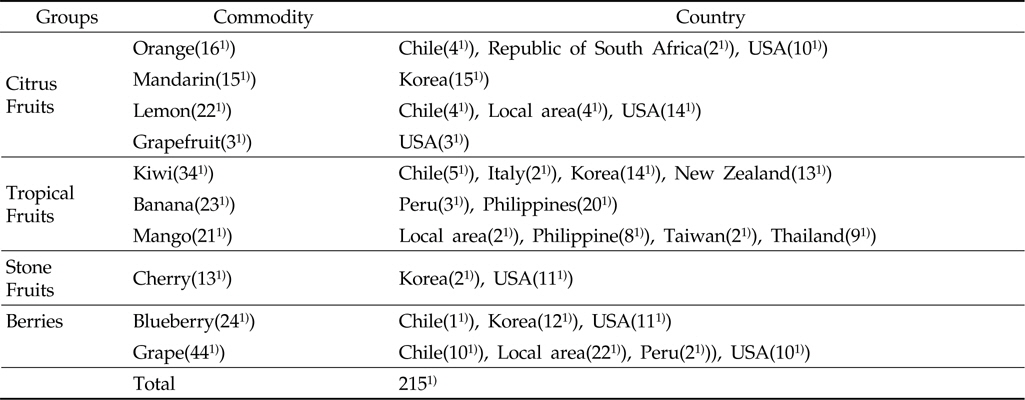
The list of collected sample number by commodity and country
잔류농약 분석용 표준품은 Dr. Ehrenstorfer GmbH(Augsburg, Bayern, Germany)에서 구입하여 사용하였고, 주로 사용되는 추출용매 acetonitrile과 전처리에 필요한 hexane, acetone, dichloromethane, methanol 등은 J. T Baker (Phillipsburg, Montana, USA)의 High Performance Liquid Chromatography(HLPC)급을 사용했으며, NaCl은 Junsei사(Osaka, Japan)을 사용하였다. GC, HPLC 분석을 위한 정제 카트리지는 Agilent사(Lake Forest, Califonia, USA)의 Florisil cartridge (1,000mg, 6nL) 와 NH2 cartridge(1,000mg, 6mL)을 각각 사용하였다. QuEChERS 시약은QuEChERS Extract EN method kit (Agilent, Lake Forest, Califonia, USA)를 사용하였다
분석기기는 정성분석을 위해 Gas Chromatography/Mass Selective Detector (GC/MSD)는 Agilent 6890 및 7890A GC에 연결된 Agilent 5973, 5975 Mass Selective Detector(Agilent, Santa clara, Califonia, USA)와 TOFMASS Detector(LECO, St. Joseph, Michigen, USA)를 사용하였고, Liquid Chromatograph/Mass/Mass(LC/MS/MS)는 TSQ Quantum Ultras(Thermo Fisher, San Jose, Califonia, USA)를 사용하였다. 정량분석을 위해 Gas Chromatography-Electron Capture Detector(GC-ECD)와 Gas Chromatography-Nitrogen Phosphorus Detector (GC-NPD)는 Agilent 6890N, 6890 (Agilent, Santa clara, Califonia, USA)와 HPLC System(SIT, Tokyo, Japan)을 사용하였다. 주요 기기분석 조건은 GC-ECD/NPD, GC-MS를 이용하여 171종, High Performance Liquid Chromatography-Photodiode Array/Fluorescence Detector(HPLC-PDA/ FLD), LC/MS/MS를 이용하여 79종을 정량 및 정성 확인하였으며, QuEChERS 방법에 의한 전처리 시료는 LC/MS/ MS를 이용하여 9종의 잔류농약을 분석하였다. 상세한 기기분석 조건은 Table 2,3,4,5와 같다.
[Table 2.] Operating condition of Gas Chromatography/Mass Selective Detector

Operating condition of Gas Chromatography/Mass Selective Detector
[Table 3.] Operating condition of Liquid Chromatograph/Mass/Mass
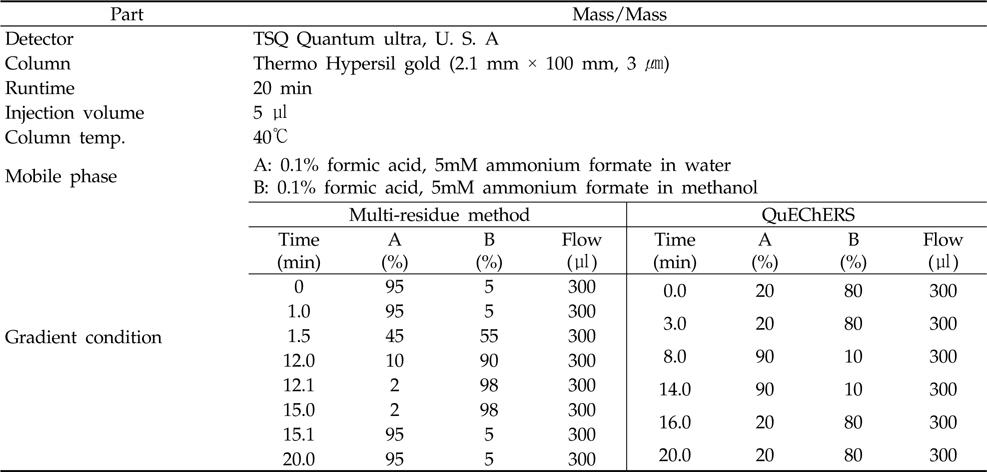
Operating condition of Liquid Chromatograph/Mass/Mass

Operating condition of Gas Chromatography-Electron Capture Detector / Nitrogen Phosphorus Detector
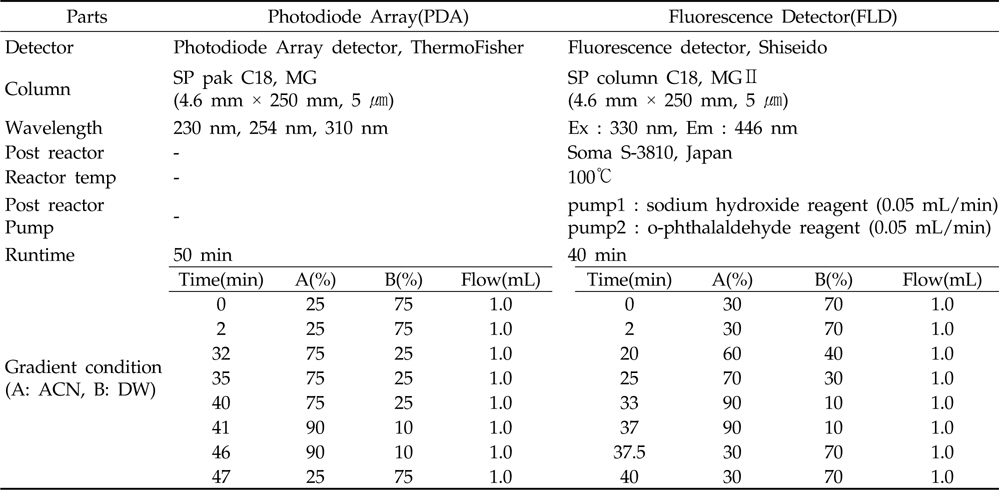
Operating condition of High Performance Liquid Chromatography-Photodiode Array Detector/Fluorescence Detector
감귤류, 열대과일류는 과실전체와 과피를 제거한 가식부위인 과육부분으로 구분하여 전처리 하였고, 핵과류와 장과류는 세척전후로 구분하여 식품공전 다종농약다성분 제2법(식품공전) 시료 전처리 방법을 따랐다. carbendazim 외 9건은 QuEChERS(Lehotay
세척방법은 수돗물 3 L에 시료 300∼500 g을 넣고 1분간 침지 후, 같은 양의 수돗물로 30초 동안 손으로 저어주면서 2회 헹군 다음, 2시간 동안 자연건조 하였다(식품의약품안전처, 2010; You
검출된 잔류농약의 위해성 평가는 1일 섭취허용량(Acceptable Daily Intake, ADI) 대비 식이섭취율을 계산하여 산출하였다(kim
식품공전 동시다성분 분석법 제2법 농약성분의 회수율은 농약이 검출되지 않은 시료에 0.1∼2.0 mg/kg 범위내의 농약표준용액을 첨가 한 후, 각 분석법에 따라 3회 반복한 결과 회수율은 72∼116%, 상대표준편차(Relative Standard Deviation, RSD%)는 0.3∼17.0%를 나타냈다(Table 6). 분석농약의 시험방법 검출한계는 0.005∼0.023 mg/kg 수준이었다. 국립농산물품관리원 잔류농약분석법 다성분 동시 분석 2법 QuEChERS/MS/MS법을 이용한 회수율은 시험결과는 Table 7과 같다. 이 결과는 국내에서 허용되는 회수율 범위 70∼120%, 상대 표준편차 20% 이하로 본 연구의 실험 수행에 적합하다고 판단하였다. imazalil, acetamiprid 의 경우 식품공전 동시다성분 분석법 제2법에 회수율이 범위 내에 포함되지 못해 국립농산물품질관리원 QuEChERS/MS/MS법으로 측정하였다.
[Table 6.] Recovery(%) and limit of detection(mg/kg) by multi-residue method in lemon
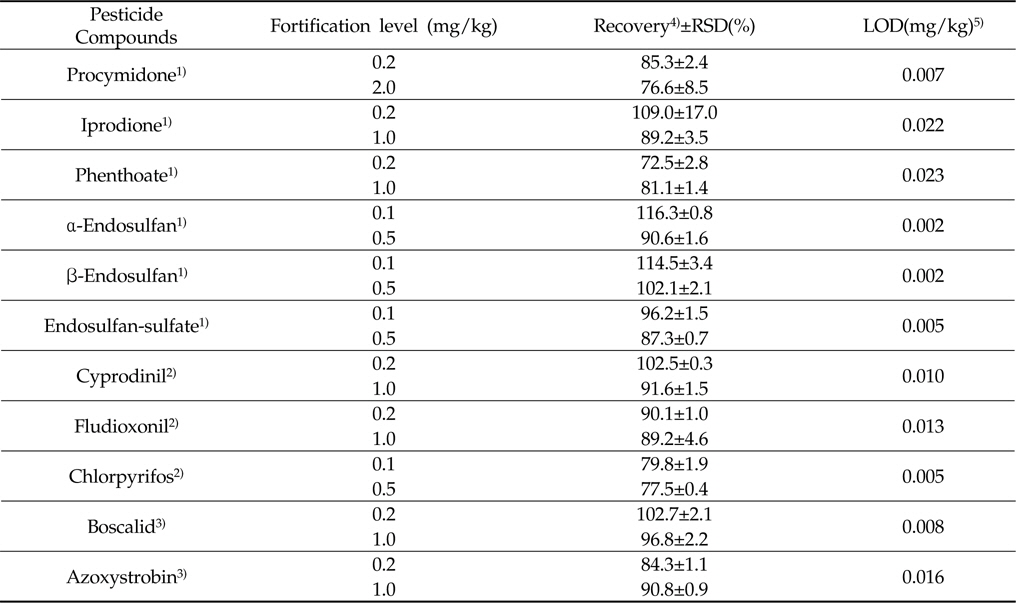
Recovery(%) and limit of detection(mg/kg) by multi-residue method in lemon
[Table 7.] Recovery(%) and limit of detection(mg/kg) by QuEChERS/MS/MS method in lemon
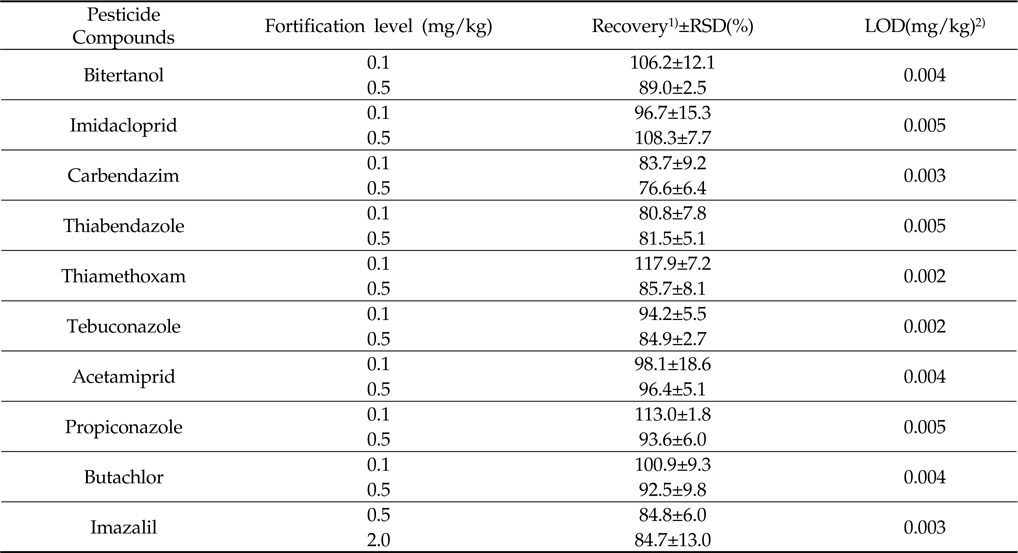
Recovery(%) and limit of detection(mg/kg) by QuEChERS/MS/MS method in lemon
인천시내 유통 중인 과일류 215건을 대상으로 잔류농약을 분석한 결과는 Table 8과 같이 총 121건에서 잔류농약이 검출되어 56.3%의 검출률을 나타냈으며, 식품의약품안전처에서 고시한 잔류농약허용기준에 따라 초과여부를 판정하였다. 해당 농산물의 잔류허용기준에 정해지지 않은 농산물에 대하여는 Codex기준, 유사농산물 최저치를 적용하여 적⋅부 판정하였다. 그 결과 농약 잔류허용기준을 초과한 과일은 없었다. 국내산과 수입산 잔류농약 검출 빈도는 각각 45.1, 60.8% 로 키위를 제외하고 수입과일류의 잔류농약 검출률이 높게 나타났다. Do 등 (2012)이 경기도 유통 수입과실류 잔류농약 검출률 14.5% 및 2005년 수입과일 잔류농약 검출률 32.5%(서울특별시 보건환경연구원보, 2005)에 비해 높은 검출률을 보이고 있다. 이 결과는 근래 소비자 단체에서 보도한 시중에 유통되는 수입과일의 잔류 농약 검사결과(소비자시민모임, 2012) 및 최근 보고된 과일류의 잔류농약 실태조사 문헌(Choi
[Table 8.] Analyzed sample number and detection rate of pesticide residues in fruits
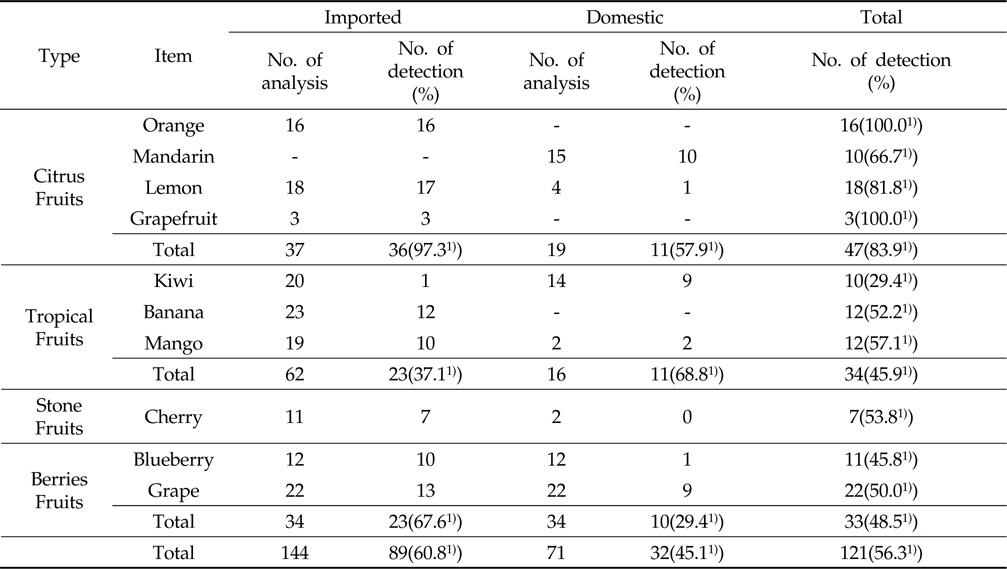
Analyzed sample number and detection rate of pesticide residues in fruits
수거한 34건의 키위 중 10건에서 잔류농약이 검출되었으며, 검출된 농약성분은 carbendazim 0.05∼0.2 mg/kg (기준 3.0 mg/kg) 7건, iprodione 0.1∼1.1 mg/kg (기준 5.0 mg/kg) 4건, procymidone 0.3∼1.1 mg/kg (기준 7.0 mg/kg) 3건이 검출되었다. 그 외에 chlorpyrifos, chlorothalonil, fenitrothion, phenthoate이 각각 1건이 검출되었다. 키위에서 검출빈도가 높은 carbendazim은 잿빛곰팡이병과 과실무름병 방제를 위해 많이 사용되는 약제로 키위가 생육하는 동안 감염을 일으켜 잠복되어 있다가 수확 후 후숙과정에서 발생하는 과실 부패를 방지하기 위하여 사용되는 농약이다(Kim
블루베리의 경우 24건 중 11건에서 잔류농약이 검출되었다. 이중 국내에서 재배되는 블루베리는 12건 중 1건에서만 농약이 검출되어서 검출률은 8.3% 로 83.3%를 나타낸 수입블루베리 생과에 비해 현저히 낮은 수준을 보였다. 이는 현재 국내 재배 블루베리가 대부분 친환경 재배기술 도입(농촌진흥청 농업기술, 2012)을 통한 경쟁력 확보에 주력하고 있기 때문으로 보인다. 블루베리에서 boscalid 0.04∼0.48 mg/kg(기준 5.0 mg/kg) 8건, azoxystrobin 0.13∼0.57 mg/kg(기준 1.0 mg/kg) 6건이 검출되었으며, 그 외에 iprodione, cyprodinil, chlorothalonil, pyraclostrobin, cypermethrin, malathion 이 각각 1건씩 검출되었다. 블루베리의 경우 별도로 설정된 잔류농약허용기준이 없어, 유사농산물 최저기준을 적용하여 적부판단을 하였다.
포도는 44건 중 22건에서 기준이내 잔류농약이 검출 되었다. 검출 농약의 종류는 procymidone 0.02∼0.06 mg/kg(기준 5.0 mg/kg) 5건, boscalid 0.02∼0.30 mg/kg (기준 1.0 mg/kg) 5건, cyprodinil 0.01∼0.13 mg/kg (기준 5.0 mg/kg) 4건, iprodione 0.08∼0.27 mg/kg (기준 10.0 mg/kg)3건, imidacloprid 0.06∼0.65 mg/kg (기준 1.0 mg/kg) 2건, dimethomorph, azoxystrobin, kresoxim-methyl, bifenthrin, spirodiclofen, trifloxystrobin, fludioxonil, pyraclostrobin, fenhexamide, myclobutanil, methoxyfenozide, pyrimethanil 등 17종 농약이 검출되었다. procymidone은 포도, 딸기, 토마토 등에 잿빛곰팡이 방제에 널리 사용되는 살균제로 국내 유통되는 농산물에 많이 검출되는 농약 중 하나이다(Ahn
품목별 농약 검출률을 보면 감귤류가 83.9%로 가장 높게 나타났다. 그중에도 수입오렌지와 레몬, 자몽은 90% 이상 농약이 검출되었다(Table 8). 이러한 결과는 Choi 등(2013) 보고한 감귤류의 살균제 분석결과와 유사한 결과를 보였다. 감귤류의 경우에 수확 후 저장 유통과정에서 부패가 발생하여 최적의 저장 조건에서도 상품가치가 떨어지는 특성이 있다. 따라서 감귤류의 수확직전 또는 수확 후 살균제를 처리하기 때문에 꾸준한 안전성 관리가 필요하다. 수입 감귤류의 경우 대표적인 Post-harvest 살균제인 imazalil 0.07∼4.13 mg/kg (기준 5.0 mg/kg), thiabendazole 0.05∼1.58 mg/kg (기준 10.0 mg/kg), fludioxonil 0.06∼2.50 mg/kg (기준 5.0 mg/kg) 및 살충제인 chlorpyrifos 0.05∼0.27 mg/kg(기준 0.3 mg/kg)이 2종 이상 동시에 검출되었다. 반면 국내산 감귤과 레몬은 수확전 해충방제를 위해 살포하는 phenthoate와 carbendazim 등이 검출되었다.
열대과일류는 총 74건 중 34건에서 잔류농약이 검출되어 45.9%의 검출률을 나타내었다(Table 8). 바나나는 52.2%에서 잔류농약이 검출되었으며, carbendazim 0.02∼0.19 mg/kg(기준 5.0 mg/kg)이 23건 중 9건, chlorpyrifos 0.02∼0.03 mg/kg (기준 0.3mg/kg) 3건, azoxystrobin 0.10∼0.18 mg/kg (기준 2.0 mg/kg) 2건, fenhexamide, iprodione, bifenthrin 이 각각 1건씩 기준 이내로 검출되었다.
망고는 21건 중 12건에서 잔류농약이 검출(57.1%) 되었고, carbendazim 0.06∼0.91 mg/kg (기준 5.0 mg/kg) 9건, azoxystrobin 0.01∼0.55 mg/kg (기준 0.7 mg/kg) 5건 검출되었다. 그 외에 endosulfan 0.13∼0.34 mg/kg (기준 0.5mg/kg) 2건, diazinon, imidacloprid, procymidone, boscalid, fenitrothion 이 각각 1건씩 검출되었다.
체리는 13건 중 7건에서 잔류농약이 검출(53.8%) 되었으며 fenpropathrin 0.06∼0.33 mg/kg (기준 5.0 mg/kg) 3 건, trifloxystrobin 0.01∼0.02 mg/kg (기준 2.0mg/kg) 2 건, iprodione, cyhalothrin, imidacloprid, acetamiprid, boscalid, fludioxonil, triflumizole 이 각각 1건씩 검출되어 총 9종의 잔류농약이 검출되었다. Fenpropathrin은 과실의 나방 및 진딧물 방제에 널리 쓰이는 살충제로 2010로 소비자시민모임 조사 결과 수입 체리에서 기준치가 초과되어 검출되었던 농약이다. 당시 체리 고유의 잔류농약허용기준이 설정되어 있지 않아 유사농산물 최저 기준인 딸기의 0.5 mg/kg 기준이 적용되었고, 2011년 잔류농약허용기준에 fenpropathrin 체리 허용기준은 5.0 mg/kg 으로 추가되었다(식품의약품안전처고시 2012-1호).
블루베리 이외에도 유통과일에 별도의 기준이 정해지지 않은 잔류농약이 많이 검출되었다. 키위에서 검출된 chlorothalonil, phenthoate, 바나나에서 검출된 carbendazim, fenhexamide, iprodione, bifenthrin, 망고의 carbendazim, azoxystrobin, endosulfan, imidacloprid, procymidone, boscalid 등은 해당품목에 별도의 잔류농약 허용기준이 설정되어 있지 않았다. 이러한 미등록 농약은 현재 국내에서는「농산물의 잔류농약 잠정기준」 적용에 따라, Codex 기준과 유사농산물 최저치를 적용하고 있다. 이는 농약잔류허용기준에 적합한 농산물 이라고 해도 안전하다고 확신 할 순 없을 것이다. 이는 소비자에게는 막연한 불안감을 조성하며 농민들의 농약 사용에도 혼선을 유발하고 있다. 따라서 안전성 확보를 위해 농민들에게 미등록 농약사용을 못하도록 농약사용 교육과 홍보가 철저하게 이루어져야겠다. 또한 과일에서 자주 검출되는 농약에 대한 위해평가를 통한 MRL 설정 등 대책마련이 필요할 것으로 보인다. 나아가 Positive list, Zero tolerance와 같은 안전관리 시스템 도입으로 잔류농약에 대한 안전성평가가 이루어지지 않은 농산물 유통을 금지시키는 등 보다 엄격한 농약잔류허용기준에 대한 관리가 필요할 것으로 생각된다.
농약 성분별 검출빈도는 수입과일의 경우 imazalil(15.4%), thiabendazole(14.2%), fludioxonil(13.0%), carbendazim(9.3%)의 순으로, 국내산 과일은 carbendazim(25.0%), procymidone(17.3%), phenthoate(11.5%), iprodione(7.7%) 순으로 나타났다. 수입과일에는 대표적인 Post-harvest 농약인 imazalil, thiabendazole 등이 높은 검출률을 나타낸 것을 확인할 수 있었다(Kruve
본 연구의 잔류농약 모니터링 결과 품목별 2회 이상 검출된 농약 15종에 대한 위해성을 평가하였다(Table 9). 검출농약의 %ADI를 살펴보면 오렌지에서 검출된 imazalil이 0.98795%, chlorpyrifos 0.20114%로 상대적으로 높은 %ADI를 나타냈으나, 오렌지의 경우 껍질을 제거 하고 섭취하기 때문에 실제 섭취하는 과육부분의 유해성은 상당히 낮아질 것으로 추정된다. 그 외 검출된 다른 성분들은 매우 낮은 수준의 %ADI 값을 나타내고 있다. 블루베리, 망고, 바나나에서 검출된 잔류 농약의 경우 해당품목의 잔류농약허용기준이 설정되지 않아Codex, 유사농산물 최저기준을 적용한 품목에 대한 위해성 평가결과 역시 0.00011∼0.19600% 로 낮은 %ADI 값을 보여 위해성 수준은 낮은 것으로 판단된다. 하지만, 과일류의 잔류농약 검출률은 상당히 높은 수준이고, 해당 과일에 별도의 잔류허용기준이 설정되어 있지 않는 농약이 높은 빈도로 검출되었기 때문에 다빈도 검출 농약에 대한 MRL 신설 및 미등록농약 사용 금지에 대한 철저한 현장교육 등이 요구 되며, 지속적인 잔류농약 모니터링을 통한 안전한 관리가 이루어지도록 노력해야 할 것이다.
[Table 9.] Risk assessment of pesticides detected from fruits
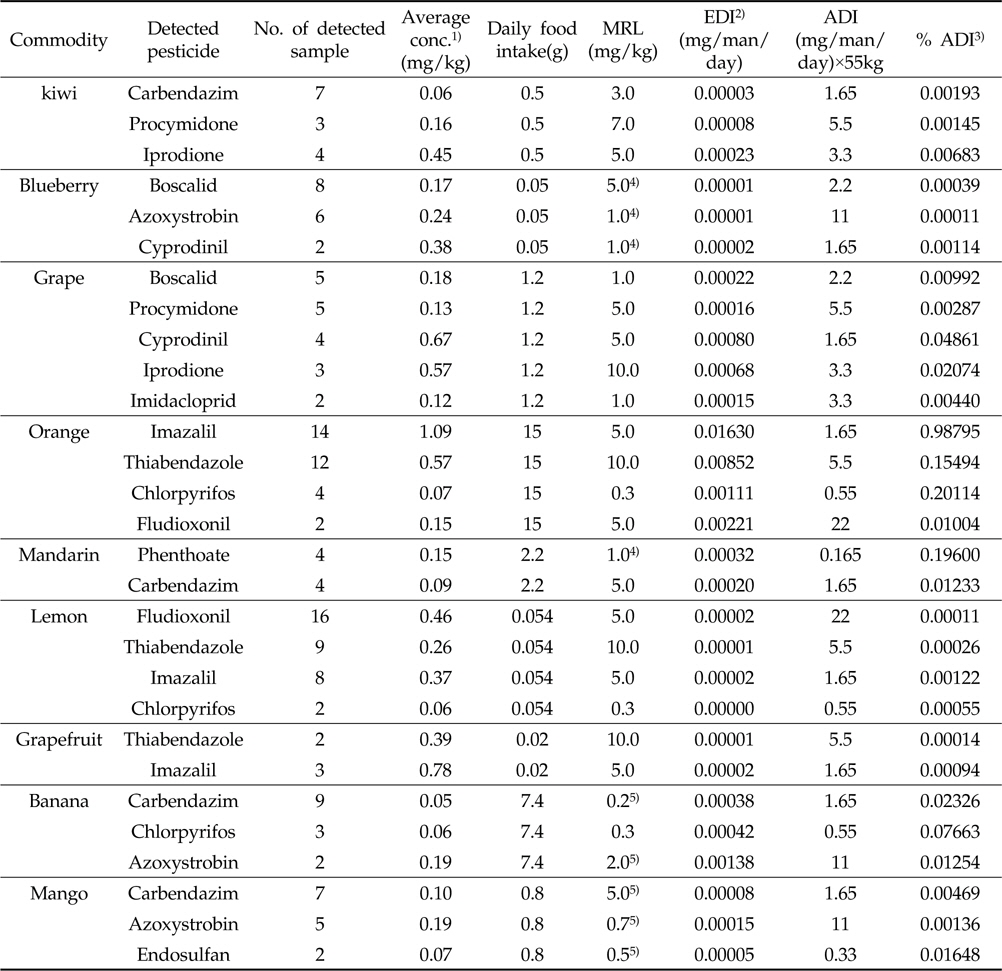
Risk assessment of pesticides detected from fruits
잔류농약 분석법에 의한 시료채취는 과피를 포함한 과실 전체를 대상으로 한다. 그러나, 실제 오렌지, 레몬, 감귤, 키위, 바나나, 망고와 같은 과일류는 대부분 과피를 제거하고 과육만을 섭취하고 있다. 따라서 본 연구에서는 과피를 제거한 과육에서 잔류농약을 검사하여 과피 제거 전후에 따른 잔류농약 제거효과를 살펴보았다(Fig. 1). 그 결과 감귤류는 평균 91.6% 잔류농약 제거효율을 나타내었다. 품목별 제거효과는 감귤이 98.6%의 가장 큰 잔류농약 제거율을 보였다. 하지만, 과피의 두께 및 농약의 침투성에 따른 농약의 잔류성에 대한 차이는 뚜렷하게 나타나지 않았다. Lee와 Lee(1997) 등의 연구에 의하면, 과일 껍질 벗기기에 의한 유기인계 농약의 제거효과는 평균 91%의 제거율을 나타낸 것과 유사한 결과를 보였다. 과일재배에 농약 사용이 불가피한 현실에서, 농약 안전사용기준을 준수하여 농약을 사용한다면 소비자가 실제로 섭취하는 과육부분의 농약은 90% 이상 제거 되므로 안전하다고 할 수 있겠다. 하지만, 감귤이나 레몬의 경우 진피부분을 포함하여 사용 할 경우에는 세심한 주의가 필요하겠다.
과피를 제거하지 않고 섭취하는 과일은 대부분의 경우 세제나 물에 의한 세척 과정을 통하여 섭취하게 된다. 세척방법에 따른 잔류농약 제거효과에 대한 다양한 연구가 이루어졌는데, 근래에는 채소 및 과일 중 잔류농약 "물⋅세제" 세척 차이가 없다고 알려져 있다(생활과 농약, 2006). 본 연구에서 블루베리, 체리, 포도를 수돗물 침지 후 세척하였을 때 잔류농약 제거율을 확인하였다(Fig. 2). 잔류농약 제거율은 체리, 포도, 블루베리의 순으로 나타났으며, 잔류농약 평균제거율은 43.1% 이었다. 농약의 물에 대한 용해도가 높을수록 제거효과가 증가하고(Ko










